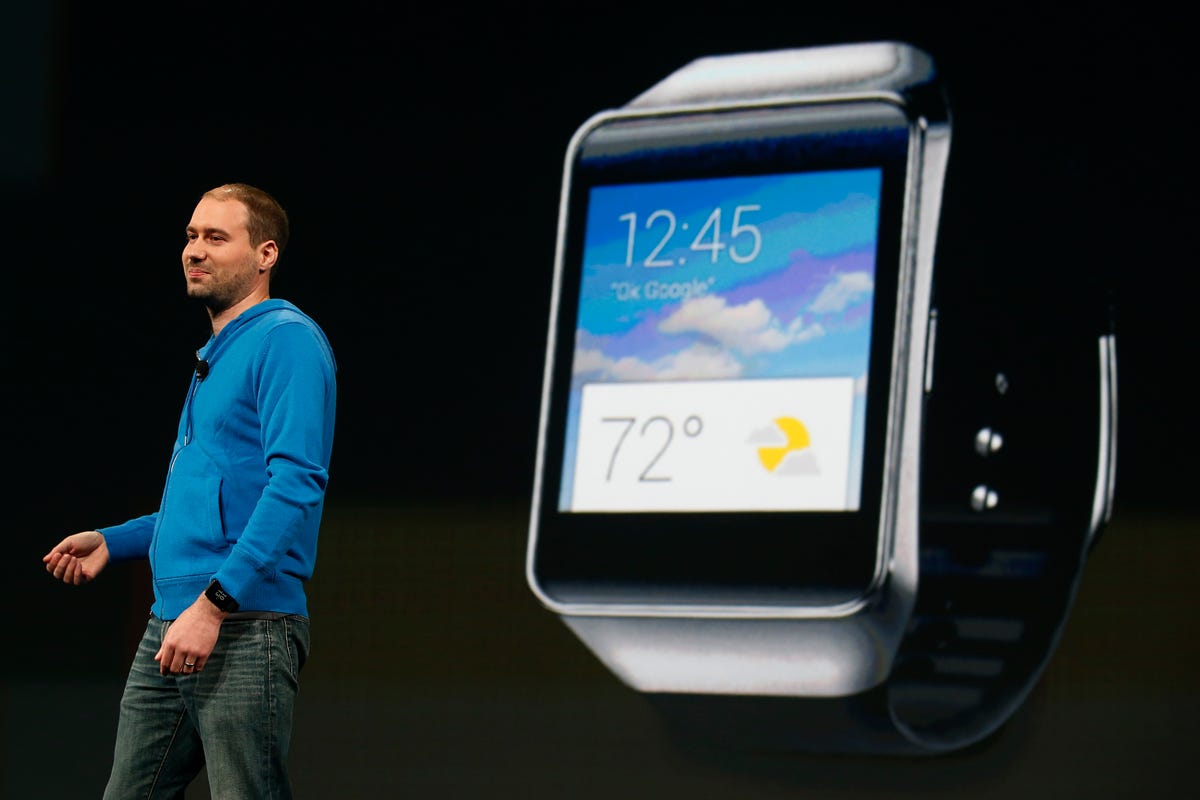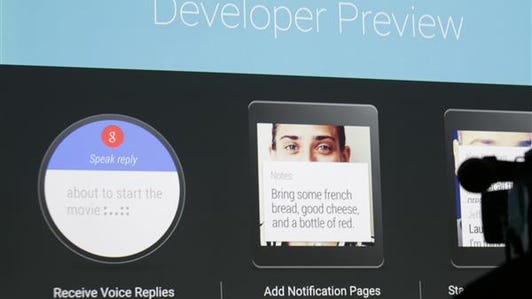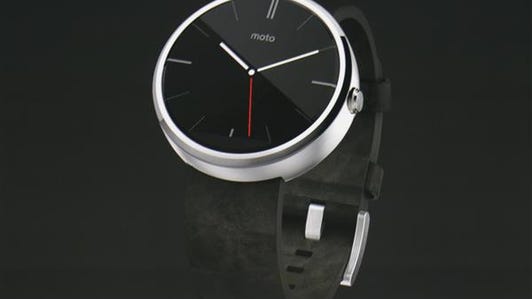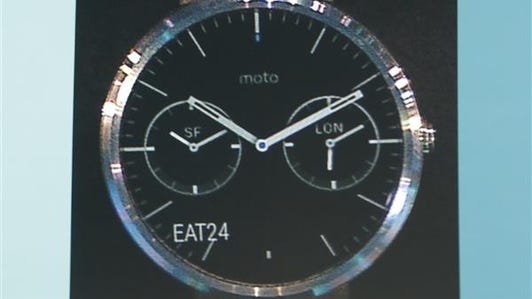
Stephen Lam/Getty Images
MOUNTAIN VIEW, Calif. — David Singleton, Google’s engineering director for Android Wear, the company’s platform tailor-made for wearable devices, is sitting in Google’s headquarters here playing air guitar.
As he strums his right hand in front of his Moto 360, the Motorola smartwatch set to hit the market this week, Singleton praises the third-party software developers using Wear. The company debuted the software in March, modified from Android, the most popular operating system in the world for smartphones and tablets.
“There are a lot of apps out there,” he says after he stops strumming, during an interview here. As for the guitar-playing program: “We would have never thought of that.”
He won’t say exactly how many apps there are, but offers that “thousands” of the more than 1 million programs in the Google Play store — where consumers download apps for their Android devices — have been updated to support Wear.


CNET
Google showed off the platform at its I/O developer conference in June, with demos on using the software to order food or hail a ride from a smartwatch. But the company has until now been mostly quiet about what’s next.
Google is readying “several” updates to Android Wear before the end of the year, with the first coming this week. Some features on the horizon include the ability to pair a smartwatch with a Bluetooth headset, Singleton says. Watches with hardware that supports GPS capabilities will also be able to use geolocation data to track their fitness sessions. So, if someone taking a run wanted to listen to music but leave her phone at home, she’d be able to store some songs on her watch, and listen to them through a set of Bluetooth headphones.
Android Wear will also let third-party developers design their own watch faces — which is what a wearer sees first when glancing at the watch — and let owners download them from the Play store. Customized watch faces — like ones that display current scores for a favorite sports team, or ones that show a certain company’s stock price — can be easily swapped out.
Some developers have already figured out how to design smartwatch faces, Singleton said, but there’s been no straightforward way to do it.
The wearables market — specifically the smartwatch part of it — is about to get a lot of attention. Three Android Wear devices have already been announced: The Moto 360, which has a round watch face and will reportedly sell for $250, LG’s $230 G Watch , and Samsung’s $200 Gear Live . Samsung also last week introduced the Gear S, the first smartwatch in its portfolio that will work independently from a smartphone (watches so far must typically be paired with another device, like a smartphone).
A handful of companies are expected to make wearables announcements at the IFA conference, Europe’s biggest tech show, in Berlin later this week. And Apple, Google’s archrival in smartphones, may also show off a wearable device of its own during a Sept. 9 press event where it’s expected to introduce a new version of the iPhone.
The category is still in its infancy, though the market has grown in the past year. In 2013, 9.7 million wearables were shipped, according to CCS Insight, a research firm. By the end of 2014, that figure is projected to jump to 22 million.
Android Wear everywhere
Google has ambitious plans for Android as a whole. At Google’s I/O conference in June, Android chief Sundar Pichai laid out plans to inject the platform into several facets of everyday life, powering everything from car dashboards to televisions to wearables.
Google’s OS has more than 1 billion active users, Pichai said, and runs on almost 80 percent of the world’s smartphones. In comparison, Apple’s iOS, which drives the iPhone and iPad, has around 17 percent share of the market.
But because Google’s software is an open platform — meaning anyone can adapt and use it — other brands, like Samsung, have modified the operating system to fit their needs. That’s left users to navigate the multiple iterations of Android running on hardware from Google’s many partners. And it’s a point that rival Apple, with its closed system around iOS, likes to drive home, calling Android fragmented.
“The overriding theme of the I/O keynote was Google reasserting control over Android,” Jan Dawson, founder of Jackdaw Research, said at the time. Because watches have limited space on their screens with simpler functions, Android Wear can be one realm where Google makes the software more uniform.
“[We’ve been] thinking about how you deliver services on a device like this that has such a small screen, that you can’t necessarily spend a lot of time interacting with,” says Singleton.
Google I/O 2014: Android wearables coming to your wrist (pictures)






But another difference that could serve Google well is the way most smartwatches (aside from Samsung’s newly announced Gear S watch) need to be paired with a phone to operate. So, Google will push out Android Wear updates without having to wait for carriers to test the software, like they generally do with phones and tablets. That should give Google more control over the software. The company says it is working closely with hardware partners to make sure the software works well with their devices.
Hiroshi Lockheimer, vice president of engineering for Android, says the goal is to be able to improve the software as fast as possible.
“It’s a lot simpler on watches,” says Lockheimer. With phones, lots of companies’ schedules have to align to make updates available. “There are different things on that pipeline that just don’t exist [with smartwatches]. And it makes it possible for us as an industry to push these updates out a lot quicker.”
Related Stories
- Google says Android Wear about to get even smarter (Q&A)
- Google spells out ambitious plan: Android world domination
- Time for Android Wear: Google shows off Samsung, LG, Motorola smartwatches
- With Gear S watch, Samsung tinkers — and tempts fate
- Apple wearable rumored to debut with iPhone 6 in September
Google has a definite stake in making sure the Android experience is consistent across the board. “It becomes much more important with wearables,” said Sameet Sinha, an analyst with the investment bank B. Riley and Co. “They are not individual devices; they need to talk to each other. It’s an ecosystem Google wants to develop.”
But wearables’ designs continue to evolve, and they may not be so co-dependent on other devices for long. Time will tell if Samsung’s Gear S watch is a harbinger or a rarity — and whether more watches will come out that have their own separate cellular connections.
Matthew Goldman, CEO of the personal finance app Wallaby, thinks Samsung’s new watch sets the trend. “It’s clear that you’re not going to need your phone,” said Goldman, who is unveiling the Android Wear version of his app on Thursday. Wallaby also runs on Google’s connected headset device Glass, the Pebble Smartwatch, and Samsung’s Gear 2, which is powered by the company’s homegrown operating system, Tizen.
Google, for its part, is waiting for more devices to take that route before building out support for cellular connections in Android Wear. “We’ll see other mechanisms for connecting, other than Bluetooth,” says Singleton. “We’ll start to enable those as we see partners wanting to build devices using them.”



